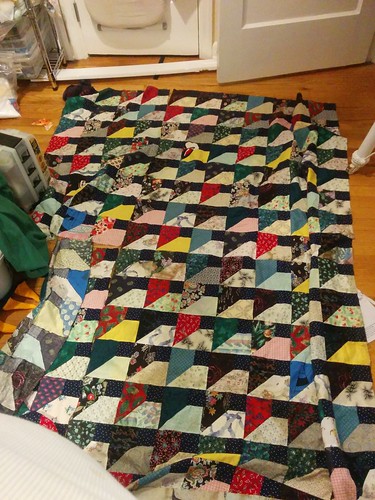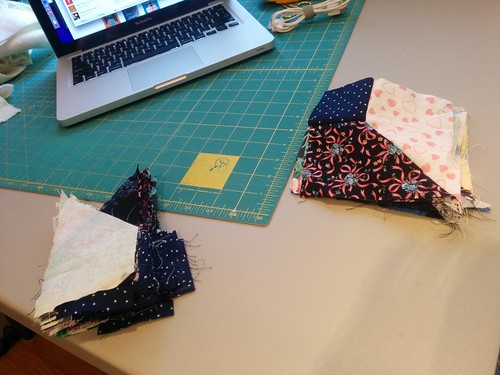evasive maneuvers
When I saved off the last entry ("the things you save from the fire") I said a rather prophetic phrase: "It was time for evasive maneuvers." To recap: I had a bag full of water- and soot-logged fabric that I'd rescued from a co-worker's basement after a house fire. Now what? Math! That's what!
(Every time I think of the word "triage," I am reminded of a co-worker who would always reply, "Remember, using that word means you know some of your patients are going to die." So, no, this was not triage, because nobody was gonna die on this watch.)
When I was helping sort the fabrics in the basement, I uncovered a total of three large squares of pieces that had been sewn together. They were each 8x8 grids of squares, like this, roughly 40" per side:
X X X X X X X X X X X X X X X X X X X X X X X X X X X X X X X X X X X X X X X X X X X X X X X X X X X X X X X X X X X X X X X X X X X X X X X X X X X X X X X X X X X X X X X X X X X X X X X X X X X X X X X X X X X X X X X X X X X X X X X X X X X X X X X X X X X X X X X X X X X X X X X X X X X X X X X X X X X X X X X X X X X X X X X X X X X X X X X X X X X X X X X X X X X X X X X X
These pieces could not be thrown in the washer as they were. I needed to stabilize the edges of as many pieces as possible, but I also needed to get these sewn sections in the wash Right The Hell Now because what smelled "just fine" in the context of the burned basement was a Choking Fog Of Augh Make It Stop™ when brought into my unburned house. MATH!
I focused on not breathing deeply, and realized if I removed one seam, I could jigsaw the pieces together from three squares to form a single large rectangle, like this:
X X X X X X X X X X X X X X X X X X X X X X X X X X X X X X X X X X X X X X X X X X X X X X X X X X X X X X X X X X X X X X X X X X X X X X X X X X X X X X X X X X X X X X X X X X X X X X X X X X X X X X X X X X X X X X X X X X X X X X X X X X X X X X X X X X X X X X X X X X X X X X X X X X X X X X X X X X X X X X X X X X X X X X X X X X X X X X X X X X X X X X X X X X X X X X X X
I tossed the pieces down quickly on the floor to confirm it would work, and began to sew. Plastic and wood both absorb odors, so I didn't want either my floor or my sewing table touching these pieces any longer than absolutely necessary prior to cleaning. Thinking of them as radioactive summed up the problem quite nicely.
What had been three 8x8 squares was now one 12x16 rectangle. I folded the piece in half, ran a line of basting stitches down each raw edge, and essentially turned it into a closed pillow. I threw it in the wash, on hot, for as long as my washer would let it stay, and realized I had some additional issues:
- The smoke smell permeated fast. I raised the windows in my sewing room immediately.
- After more than about ten minutes of work, my clothing was picking up the smell.
- So was I.
Thus the rules began to develop. Windows wide open before starting work. Work no longer than a half-hour, then deal with the pieces -- either get them stowed in airtight bags or get them in the wash. Preferably the latter. Then scrub myself: all clothing worn while working had to immediately go in the washer on hot, and I had to shower to get the smell off of me. I needed to work fast, work smart, and get those pieces stabilized as quickly as possible so that I didn't have to do a full decontamination run after only 30 minutes of work.
I held my breath (literally and, sometimes, figuratively) while waiting for the pieces to come out of the washer for the first time. Would they be ANY better? Answer: yes, they were, though not perfect. I threw them right back in the washer again and gave them a second bout of cleaning, and they came out even better, starting to smell like old cotton that had been exposed to smoke rather than recent refugees of a full-blown house fire.
I considered this good enough progress to continue with the project. Next was to find out what I had. Same plan: windows up, open the bag, and work fast.
In the bag were a few assorted pieces of fabric that had nothing to do with the project, and a large volume of fabric pieces that were -- o frabjous day! -- actually sorted for sewing. The pattern wasn't hard, and it was easy to recreate how the squares were sewn, so I got started. I didn't know how many pieces I'd get, because quite frankly I couldn't stand them long enough to sit there and count them, but the faster I got them sewn, the faster I could stabilize them and make them non-radioactive.
The rhythm was pretty simple. Have two zip-top bags handy; place raw pieces in one bag and the finished squares in the other. I had room to chain-sew and lay out about four squares' worth of pieces, so pull the pieces for four squares. Sew them together. Shove them in the bag. Work as fast as possible, and stop after 30 minutes. Seal both bags. Leave the room. Dump my clothing in the washer, hop in the shower, clean up, change into clean clothes, let the room air out. Return a few hours later and do it all over again.
Anyone who wants to complain why there aren't more photos of the blocks at this stage can come over and smell the blocks, and you'll marvel that photos exist at all.
Next entry, I'll talk about finishing up the squares, seaming them up, getting them washed, and then I'll talk about what I'll do with them once they're no longer radioactive.



Comments
Wash the quilt with Borax. It
Wash the quilt with Borax. It is very gentle and a great deodorizer. I would soak everything in it for 20 minutes. A 5 gallon Home Depot bucket is perfect for this.
Borax can be found at the hardware store.